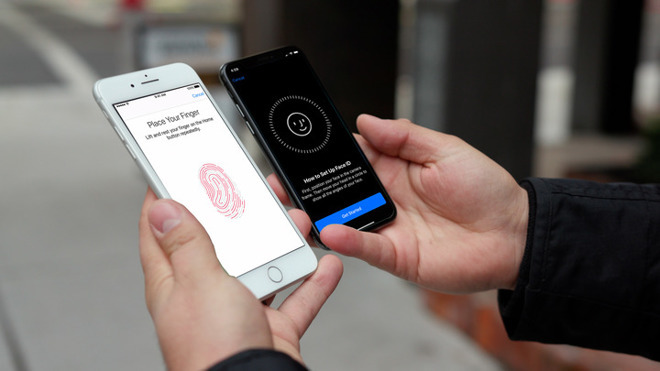An iPhone with in-screen Touch ID could ship as soon as 2021
Apple analyst Ming-Chi Kuo isn't limiting himself to rumors about 2019 and 2020 phones, and has published one now predicting that the 2021 iPhone will have both Face ID and Touch ID.

In a note published on early Monday morning, Ming-Chi Kuo predicts that the 2021 iPhone may adopt fingerprint on display (FOD) technology in 2021. The expected supplier of the technology is Qualcomm, using its ultrasonic technology, rather than others that have been developed over the last year or so.
Kuo believes that "four critical technical issues" will improve in the next 12 to 18 months. Limiting factors cited are module thickness, sensing area, power consumption, and lamination yield rate.
Apple has filed patents on the technology, which Kuo believes proves Apple's continued interest in implementing under-screen solutions. In April, Apple was granted a patent to turn the entire display into a fingerprint reader by taking advantage of acoustic imaging -- exactly what Kuo has predicted here.
A slightly different implementation is apparently also in the works, using a series of pinholes in the display panel, which would allow for an optical sensor. It is less likely that this method will be used, according to Kuo, however.
Apple maintains that the chance of another face matching a stored user is about one in a million. Identical twins have on occasion fooled the system, and it is possible to train the system with a failed Face ID unlock and a PIN entry to identify two people that look substantively alike. Touch ID has a one in 50,000 unlock with somebody else's fingerprint.

In a note published on early Monday morning, Ming-Chi Kuo predicts that the 2021 iPhone may adopt fingerprint on display (FOD) technology in 2021. The expected supplier of the technology is Qualcomm, using its ultrasonic technology, rather than others that have been developed over the last year or so.
Kuo believes that "four critical technical issues" will improve in the next 12 to 18 months. Limiting factors cited are module thickness, sensing area, power consumption, and lamination yield rate.
Apple has filed patents on the technology, which Kuo believes proves Apple's continued interest in implementing under-screen solutions. In April, Apple was granted a patent to turn the entire display into a fingerprint reader by taking advantage of acoustic imaging -- exactly what Kuo has predicted here.
A slightly different implementation is apparently also in the works, using a series of pinholes in the display panel, which would allow for an optical sensor. It is less likely that this method will be used, according to Kuo, however.
Apple maintains that the chance of another face matching a stored user is about one in a million. Identical twins have on occasion fooled the system, and it is possible to train the system with a failed Face ID unlock and a PIN entry to identify two people that look substantively alike. Touch ID has a one in 50,000 unlock with somebody else's fingerprint.


Comments
Maybe Touch Id in the summer, and Face Id in the winter?
There are rumours of so called 'waterfall displays' being released in the next two months. The question remains on what will happen to physical buttons on the sides as a result but perhaps just holding the phone might be enough to unlock it safely at some point in the next few years.
Is there nothing attractive from the current year models?
Last week it was all taking about models in 2020 and today talking about 2021.
why not talk about the models in 2030?
FaceID isn’t going anywhere. It’s to tied in to what Apple is doing with AR. Even on Apple’s cheapest phone, AR (FaceID) will be supported...
While I prefer TouchID to FaceID. Multiple authentication methods (support) would be better. For example, a FaceID + Yubikey + Pin. Or, FaceID + voice authentication.
Users should be able to set whatever method they want, including multi user authentication.
You might also want to set a backup... TouchID (right hand pinky + left hand pinky + right hand middle finger).
If you set that up (in addition to) device wipe after 8 attempts... that would be very secure.
With the TouchID combo (backup) you could let your kids, spouse, executor, etc. know and they could use your corpse to unlock your phone.
You’d need to be able to turn off Apple’s timed lockout for that method.
Bottom line, more options are better.
So with all of that said, Sync3 in my Ford Edge Sport does a great job overall but my iPhone is very difficult to wake up when in the cradle (trying to access at a stop light or not in motion) and FaceID is practically useless requiring the input of the code. TouchID would be preferable in this situation.
That said, I'd take TouchID back in a heartbeat. Turns out that two of my common iPhone use-cases are on the table, off to the side, without getting picked up; and pulling out of pocket, and glancing down out hip-height without holding up to face.
I'm switching back to an iPhone SE part-time; between TouchID (v1!) and the shorter screen travel, it's hilarious how much faster and more nimble it feels than my 10S.
I think they can currently request the device unlocked with FaceID or TouchID. I don’t think they can demand a pin/password or device like Yubikey. I bet Tennessee is going to have a bunch of court dates to schedule...
I wonder about voice authentication...
But, that just goes to show that Apple needs multi factor authentication... (from a user standpoint).